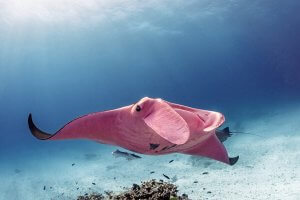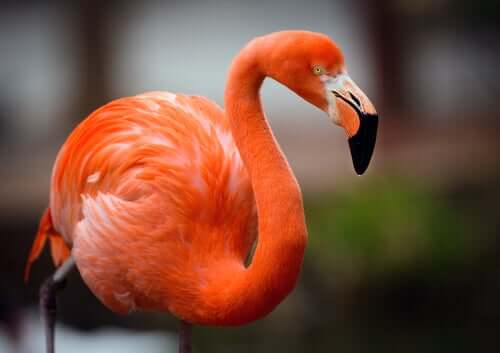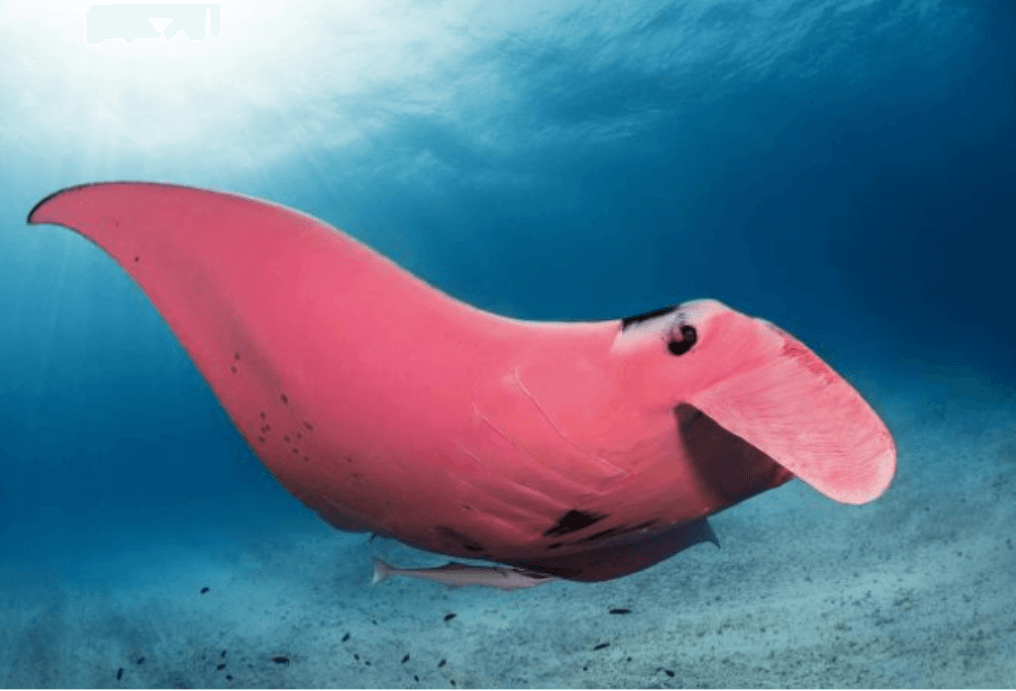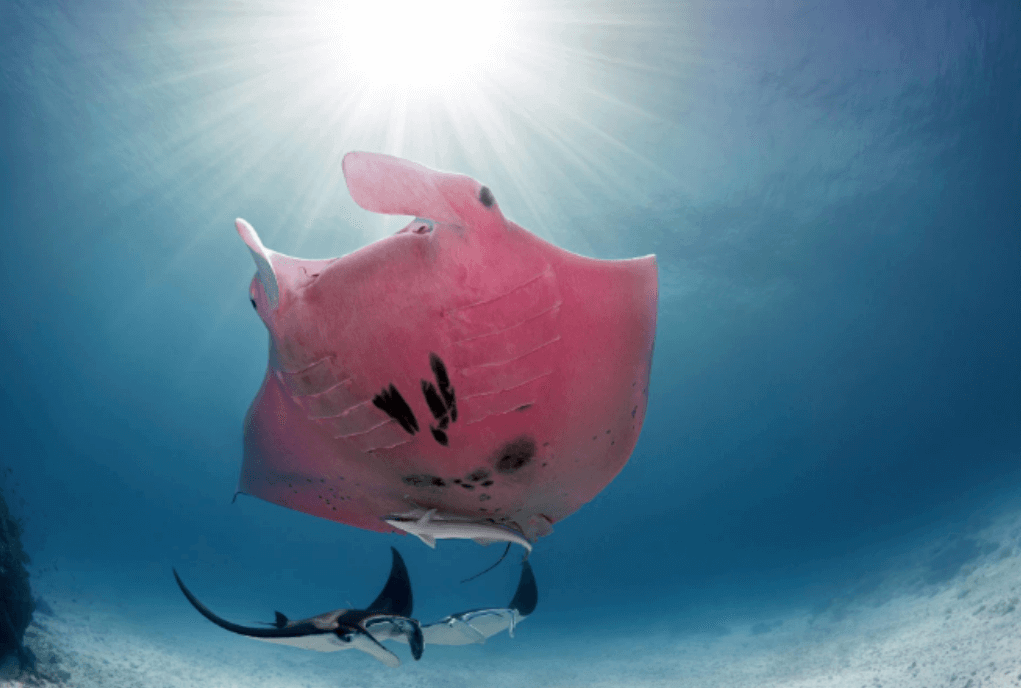The Pink Manta Ray of the Great Barrier Reef


Written and verified by biochemistry Luz Eduviges Thomas-Romero
Just earlier this year, the only known pink manta ray made its latest appearance. Photographer Kristian Laine photographed the animal while scuba diving in the waters near Lady Elliot Island, the southernmost reef of the Great Coral Reef of Australia.
In a very short time, Laine’s photographs went viral on social media, reviving curiosity regarding the ray. And it’s no wonder, considering that scientists didn’t even know the animal existed until its first appearance in 2015.
The famous pink manta ray belongs to the species Mobula alfredi, of the Mobulidaed family. It’s recognized as the second-largest manta ray species in the world.
This animal received the nickname “inspector Clouseau”, a reference to the famous character from the Pink Panther series.
What explains the manta ray’s color?
Carotenoid pigments are responsible for many of the pink, orange, and yellow colors we find in the natural world. And, at least for most animals, these molecules must be acquired through ingestion. For example, pink flamingos obtain their color from eating small crustaceans. So, with this in mind, scientists originally believed that the pink manta ray got its color as a result of diet.

Carotenoid pigments, found in shrimps and clams, are responsible for the color of its feathers.
The new pattern of the pink manta ray is black and pink
It’s worth saying that manta rays of the coral reef generally come in three color patterns. These include all black, all white, or black and white. In the case of this final variation, which is the most common, the fish has a black back and a white belly.
Therefore, when seen from above, their dark backs blend in with the darker water below. And then seen from below, their clear bellies blend in with the brights sunlit surface of the sea. Therefore, rays with a black and white pattern have the greatest advantage when it comes to protecting themselves from predators, such as sharks.

Why does the color of animals matter?
In general, coloring plays an important role in various aspects of an animal’s life. Just as we mentioned above, it can offer visual protection against predators.
At the same time, on many occasions, an animal’s color can provide valuable information. For example, the animal’s sex, physical state, maturity, or availability for production. For this reason, natural selection tends to eliminate any aberration that occurs.
However, there are several examples where individuals–or even entire populations–are characterized for having an aberrant color, like that of the pink manta ray. Thanks to its color pattern, the animal can survive and reproduce.
So, is the coloring of the pink manta ray aberrant?
Yes, this is an example of one of the diverse color aberrations scientists have discovered in the animal kingdom. Although their nomenclature is not consensual, more than a dozen color aberrations exist. These include albinism, melanism, and leucism, and erythrism. Undoubtedly, the last is one of the rarest aberrations.
Erythrism refers to a color condition in animals with excessive production and deposit of red and orange pigments (erythrophores) with various tones and grades of intensity.
Do these aberrations offer animals any advantage?
The most common – melanistic individuals that are entirely black – enjoy a thermic advantage. This is because of the superior thermoregulation capacities that the dark color of their bodies offer. At the same time, they also suffer less pressure from predation.
Cases like albinism and leucism–lack of coloration–are also common color anomalies. Without a doubt, individuals that have these aberrations in nature have a lower survival rate.
There’s no data available regarding the benefit of selective mechanisms or the thermoregulation of erythrism. Experiments with salamanders (Plethodon cinereus) demonstrated that birds selectively avoid attacking erythric individuals that are normally this color.

What explains this coloring?
Until now, three classes of chromatophores impact the coloring of marine creatures:
- Melanophores (cells with brown or black pigment)
- Xanthophores (cells with yellow and red pigment)
- Iridophores (produce an iridescent and reflective brightness)
Commonly, aberrant colorings tend to be the result of genetic mutations. These mutations affect development, the distribution of chromatophores, or the production of pigments.
However, the identification of genes that are important for the transport, deposit, and processing of carotenoids (red coloring) has been difficult. This is not the case of the well-characterized genes involved in the paths of melanogenesis (black coloring).
In any case, until now, scientists have underestimated an adaptive evolution of the color aberrations of sea creatures. The study of the phenomenon of reddish hues requires further investigation.
*Cover image courtesy of Kristian Laine.
Just earlier this year, the only known pink manta ray made its latest appearance. Photographer Kristian Laine photographed the animal while scuba diving in the waters near Lady Elliot Island, the southernmost reef of the Great Coral Reef of Australia.
In a very short time, Laine’s photographs went viral on social media, reviving curiosity regarding the ray. And it’s no wonder, considering that scientists didn’t even know the animal existed until its first appearance in 2015.
The famous pink manta ray belongs to the species Mobula alfredi, of the Mobulidaed family. It’s recognized as the second-largest manta ray species in the world.
This animal received the nickname “inspector Clouseau”, a reference to the famous character from the Pink Panther series.
What explains the manta ray’s color?
Carotenoid pigments are responsible for many of the pink, orange, and yellow colors we find in the natural world. And, at least for most animals, these molecules must be acquired through ingestion. For example, pink flamingos obtain their color from eating small crustaceans. So, with this in mind, scientists originally believed that the pink manta ray got its color as a result of diet.

Carotenoid pigments, found in shrimps and clams, are responsible for the color of its feathers.
The new pattern of the pink manta ray is black and pink
It’s worth saying that manta rays of the coral reef generally come in three color patterns. These include all black, all white, or black and white. In the case of this final variation, which is the most common, the fish has a black back and a white belly.
Therefore, when seen from above, their dark backs blend in with the darker water below. And then seen from below, their clear bellies blend in with the brights sunlit surface of the sea. Therefore, rays with a black and white pattern have the greatest advantage when it comes to protecting themselves from predators, such as sharks.

Why does the color of animals matter?
In general, coloring plays an important role in various aspects of an animal’s life. Just as we mentioned above, it can offer visual protection against predators.
At the same time, on many occasions, an animal’s color can provide valuable information. For example, the animal’s sex, physical state, maturity, or availability for production. For this reason, natural selection tends to eliminate any aberration that occurs.
However, there are several examples where individuals–or even entire populations–are characterized for having an aberrant color, like that of the pink manta ray. Thanks to its color pattern, the animal can survive and reproduce.
So, is the coloring of the pink manta ray aberrant?
Yes, this is an example of one of the diverse color aberrations scientists have discovered in the animal kingdom. Although their nomenclature is not consensual, more than a dozen color aberrations exist. These include albinism, melanism, and leucism, and erythrism. Undoubtedly, the last is one of the rarest aberrations.
Erythrism refers to a color condition in animals with excessive production and deposit of red and orange pigments (erythrophores) with various tones and grades of intensity.
Do these aberrations offer animals any advantage?
The most common – melanistic individuals that are entirely black – enjoy a thermic advantage. This is because of the superior thermoregulation capacities that the dark color of their bodies offer. At the same time, they also suffer less pressure from predation.
Cases like albinism and leucism–lack of coloration–are also common color anomalies. Without a doubt, individuals that have these aberrations in nature have a lower survival rate.
There’s no data available regarding the benefit of selective mechanisms or the thermoregulation of erythrism. Experiments with salamanders (Plethodon cinereus) demonstrated that birds selectively avoid attacking erythric individuals that are normally this color.

What explains this coloring?
Until now, three classes of chromatophores impact the coloring of marine creatures:
- Melanophores (cells with brown or black pigment)
- Xanthophores (cells with yellow and red pigment)
- Iridophores (produce an iridescent and reflective brightness)
Commonly, aberrant colorings tend to be the result of genetic mutations. These mutations affect development, the distribution of chromatophores, or the production of pigments.
However, the identification of genes that are important for the transport, deposit, and processing of carotenoids (red coloring) has been difficult. This is not the case of the well-characterized genes involved in the paths of melanogenesis (black coloring).
In any case, until now, scientists have underestimated an adaptive evolution of the color aberrations of sea creatures. The study of the phenomenon of reddish hues requires further investigation.
*Cover image courtesy of Kristian Laine.
All cited sources were thoroughly reviewed by our team to ensure their quality, reliability, currency, and validity. The bibliography of this article was considered reliable and of academic or scientific accuracy.
- Augliere. (2020). How did this rare pink manta get its color? National Geographic. https://www.nationalgeographic.com/animals/2020/02/pink-manta-ray-australia-rare/
- Esatbeyoglu, T., & Rimbach, G. (2017). Canthaxanthin: From molecule to function. Molecular nutrition & food research, 61(6), 1600469.
- Fox, D.L. (1979). Pigment transactions between animals and plants. Biological Reviews, 54(3), 237-268. https://onlinelibrary.wiley.com/doi/abs/10.1111/j.1469-185X.1979.tb01012.x
- Needham, A. E. (2012). The significance of zoochromes (Vol. 3). Springer Science & Business Media.
- Tilley, S. G., Lundrigan, B. L., & Brower, L. P. (1982). Erythrism and mimicry in the salamander Plethodon cinereus. Herpetologica, 409-417.
This text is provided for informational purposes only and does not replace consultation with a professional. If in doubt, consult your specialist.








